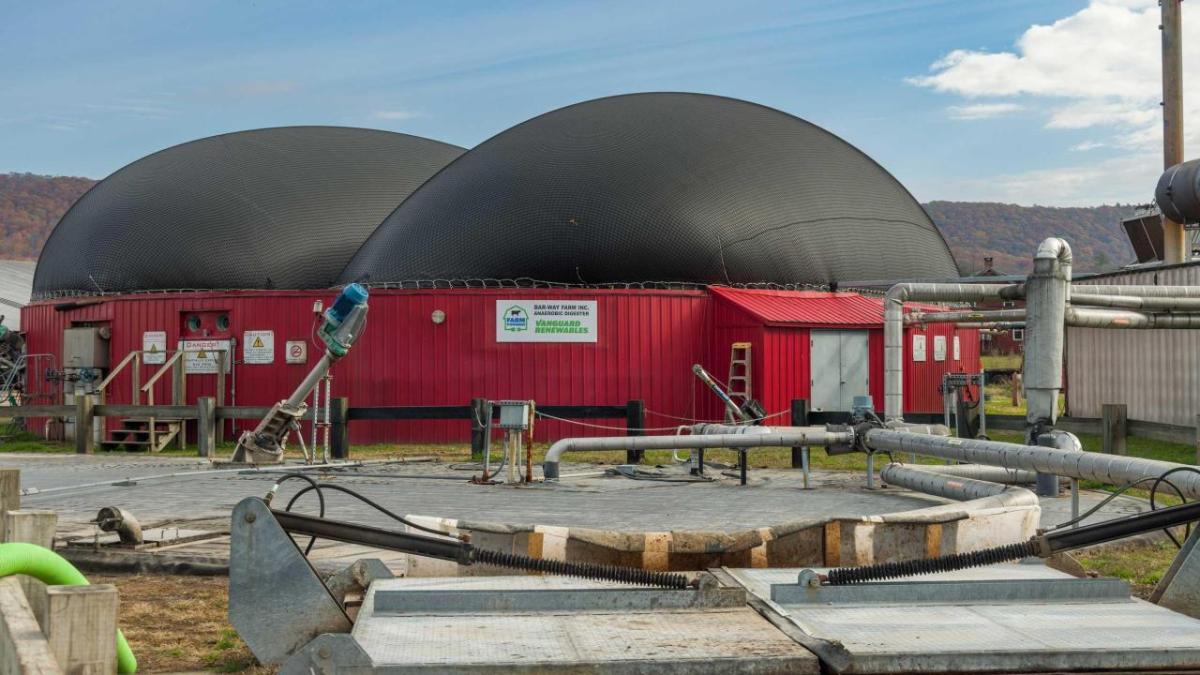Demystifying Farm Powered® Anaerobic Digestion
CSRWire - Demystifying Farm Powered® Anaerobic Digestion: Harnessing the Power of Waste CSRwire.com


Sustainable Development Goals and Farm Powered Anaerobic Digestion
Published on 03-01-24 by Vanguard Renewables

Farm Powered anaerobic digestion is a powerful process that recycles organic waste, mainly food and beverage waste from the manufacturing sector and dairy cow manure, into renewable natural gas (RNG). It’s a pretty simple process – think of it as a giant Crock-Pot that is full of methanogens – which are naturally found in cow manure – that gobbles up the food waste and the manure and creates biogas. That biogas is then cleaned, upgraded, and becomes a powerful tool to fight climate change – renewable natural gas. A drop-in replacement for fossil natural gas and is one of the tools in our toolbox to mitigate climate change.
How Does Farm Powered Anaerobic Digestion Work
Watch the fun explainer video above.
Waste is Only Waste if You Waste It
Food waste is a fact of life, whether it be in a home or at a factory. If a cookie manufacturer added baking powder instead of baking soda to their batter, that whole industrial batch of cookies would need to be discarded. That’s a lot of cookies that can’t be sent to feed those in need but would be sent to the landfill.
For dairy farmers, manure presents some smelly challenges. Like food waste, you can’t have dairy cows without cow manure. There are several ways that farmers and food and beverage companies can handle their unavoidable waste. We believe that recycling them together through anaerobic digestion provides a sustainable solution for both dairy farmers and food and beverage manufacturers.
There are many benefits of recycling food waste and dairy cow manure through anaerobic digestion, creating positive impacts on waste management, renewable energy generation, greenhouse gas reduction, and sustainable agriculture.
Waste Management and Environmental Benefits
Food waste and dairy cow manure can present waste management challenges. When it comes to manure from dairy cows, The U.S.D.A. Natural Resources Conservation Service estimates “that the manure from 200 milking cows produces as much nitrogen as sewage from a community of 5,000 to 10,000 people.” While this manure is most commonly used as a beneficial source of nutrients for crops, inclusion of an anaerobic digester reduces emissions associated with manure storage and generates renewable energy.
Improper disposal of organic waste leads to harmful methane emissions, increased landfill volumes, and wasted resources. However, through anaerobic digestion, these organic materials can be efficiently converted into renewable energy and valuable byproducts such as a digestate that can be used as a low-carbon and nutrient dense fertilizer, and the solids which become bedding for the herd.
Biogas is a key product of anaerobic digestion, comprising primarily methane and carbon dioxide. By capturing and utilizing biogas as a renewable energy source, we can reduce reliance on fossil fuels, combat climate change, and lower greenhouse gas emissions. The methane recovered from organic waste is a potent greenhouse gas, and preventing its release through anaerobic digestion significantly mitigates its environmental impact.
Digestate, the liquid left after anaerobic digestion, is a nutrient-rich material that can be used as a fertilizer. Applying digestate to croplands replenishes soil nutrients, reduces the need for synthetic fertilizers, and promotes regenerative agriculture practices. This approach minimizes waste and contributes to a circular economy, enhancing overall resource efficiency.
Renewable Energy Generation
RNG can be combusted in engines or turbines to produce electricity, which can be utilized on-site or fed into the power grid. This renewable energy source can power homes, businesses, and even entire communities, reducing the dependence on fossil fuel-based electricity.
It can also be used for heat production in industrial processes, space heating, or water heating. By displacing conventional natural fossil heating fuels with RNG, we can reduce the carbon footprint of these applications, contributing to a more sustainable energy mix.
Recently, AstraZeneca and Vanguard Renewables entered a transformative partnership to fuel all their U.S. operations in the U.S. by 2026. Waste Dive has referred to the partnership as the “largest open market RNG deal yet.” This is a game changer for companies that are trying to reach their net zero carbon targets, by decarbonizing their thermal load.
RNG can also be upgraded to biomethane, a renewable natural gas, which can be used as a low-carbon fuel for vehicles. This presents an opportunity to decarbonize transportation and reduce greenhouse gas emissions in the transportation sector.
Agricultural Sustainability and Nutrient Management
Dairy cow manure can be effectively managed through anaerobic digestion. Anaerobic digestion helps mitigate the environmental impact of manure by reducing methane emissions and minimizing odor issues. It also provides a means to manage the nutrient content of the manure more effectively.
Digestate, the nutrient-rich byproduct of anaerobic digestion, can be applied to cropland as a fertilizer, replenishing soil nutrients and improving soil health. This promotes sustainable agriculture practices, reduces the need for synthetic fertilizers, and minimizes nutrient runoff, which can pollute water bodies. The digestate can be another source of cost savings for our farmers since they no longer have to rely on traditional fertilizers. Many of Vanguard’s host farms have seen an increase in crop yields, and they believe it is from the use of the digestate.
By recycling dairy cow manure through anaerobic digestion, farmers can enhance nutrient management, improve soil fertility, and reduce the environmental impact associated with traditional manure management practices.
Additionally, the solids that come from the pressing of the digest
SDGs, Targets, and Indicators
-
SDGs Addressed
- SDG 7: Affordable and Clean Energy
- SDG 9: Industry, Innovation, and Infrastructure
- SDG 12: Responsible Consumption and Production
- SDG 13: Climate Action
- SDG 15: Life on Land
-
Specific Targets
- Target 7.2: Increase the share of renewable energy in the global energy mix
- Target 9.4: Upgrade infrastructure and retrofit industries to make them sustainable
- Target 12.3: Halve per capita global food waste at the retail and consumer levels and reduce food losses along production and supply chains
- Target 13.2: Integrate climate change measures into national policies, strategies, and planning
- Target 15.1: Ensure the conservation, restoration, and sustainable use of terrestrial and inland freshwater ecosystems and their services
-
Indicators
- Indicator 7.2.1: Renewable energy share in the total final energy consumption
- Indicator 9.4.1: CO2 emissions per unit of value added in manufacturing industries and construction
- Indicator 12.3.1: Global food loss index
- Indicator 13.2.1: Number of countries that have communicated the establishment or operationalization of an integrated policy/strategy/plan
- Indicator 15.1.1: Forest area as a proportion of total land area
Analysis
SDGs Addressed
The issues highlighted in the article are connected to multiple Sustainable Development Goals (SDGs). These include:
- SDG 7: Affordable and Clean Energy – The article discusses the generation of renewable natural gas (RNG) through anaerobic digestion, which contributes to clean energy production.
- SDG 9: Industry, Innovation, and Infrastructure – The article mentions the development of anaerobic digestion facilities and the partnership between AstraZeneca and Vanguard Renewables to fuel their operations, which aligns with the goal of sustainable infrastructure.
- SDG 12: Responsible Consumption and Production – The article emphasizes the recycling of food waste and dairy cow manure through anaerobic digestion, promoting responsible consumption and sustainable production practices.
- SDG 13: Climate Action – The article highlights the use of renewable natural gas as a drop-in replacement for fossil natural gas, contributing to climate change mitigation.
- SDG 15: Life on Land – The article discusses the benefits of anaerobic digestion in terms of waste management, renewable energy generation, and sustainable agriculture, which are relevant to the conservation and sustainable use of terrestrial ecosystems.
Specific Targets
The article provides information that relates to specific targets under the identified SDGs:
- Target 7.2: Increase the share of renewable energy in the global energy mix – The article discusses the production of renewable natural gas through anaerobic digestion, which contributes to increasing the share of renewable energy.
- Target 9.4: Upgrade infrastructure and retrofit industries to make them sustainable – The article mentions the development of anaerobic digestion facilities, which aligns with the target of sustainable infrastructure.
- Target 12.3: Halve per capita global food waste at the retail and consumer levels and reduce food losses along production and supply chains – The article emphasizes the recycling of food waste through anaerobic digestion, which helps reduce food waste and losses.
- Target 13.2: Integrate climate change measures into national policies, strategies, and planning – The article highlights the use of renewable natural gas as a tool to fight climate change, indicating the integration of climate change measures.
- Target 15.1: Ensure the conservation, restoration, and sustainable use of terrestrial and inland freshwater ecosystems and their services – The article discusses the benefits of anaerobic digestion in terms of waste management, renewable energy generation, and sustainable agriculture, which contribute to the conservation and sustainable use of terrestrial ecosystems.
Indicators
The article mentions or implies indicators that can be used to measure progress towards the identified targets:
- Indicator 7.2.1: Renewable energy share in the total final energy consumption – The article discusses the generation of renewable natural gas through anaerobic digestion, which contributes to the renewable energy share in the energy mix.
- Indicator 9.4.1: CO2 emissions per unit of value added in manufacturing industries and construction – The article highlights the partnership between AstraZeneca and Vanguard Renewables to fuel their operations with renewable natural gas, which can help reduce CO2 emissions in the manufacturing industry.
- Indicator 12.3.1: Global food loss index – The article emphasizes the recycling of food waste through anaerobic digestion, which can contribute to reducing food losses along production and supply chains.
- Indicator 13.2.1: Number of countries that have communicated the establishment or operationalization of an integrated policy/strategy/plan – The article mentions the use of renewable natural gas as a tool to fight climate change, indicating the integration of climate change measures in national policies, strategies, or plans.
- Indicator 15.1.1: Forest area as a proportion of total land area – Although not explicitly mentioned in the article, the benefits of anaerobic digestion in terms of waste management, renewable energy generation, and sustainable agriculture contribute to the conservation and sustainable use of terrestrial ecosystems, which can be measured by the forest area as a proportion of total land area.
Table: SDGs, Targets, and Indicators
| SDGs | Targets | Indicators |
|---|---|---|
| SDG 7: Affordable and Clean Energy | Target 7.2: Increase the share of renewable energy in the global energy mix | Indicator 7.2.1: Renewable energy share in the total final energy consumption
Behold! This splendid article springs forth from the wellspring of knowledge, shaped by a wondrous proprietary AI technology that delved into a vast ocean of data, illuminating the path towards the Sustainable Development Goals. Remember that all rights are reserved by SDG Investors LLC, empowering us to champion progress together. Source: csrwire.com
Join us, as fellow seekers of change, on a transformative journey at https://sdgtalks.ai/welcome, where you can become a member and actively contribute to shaping a brighter future.
|








